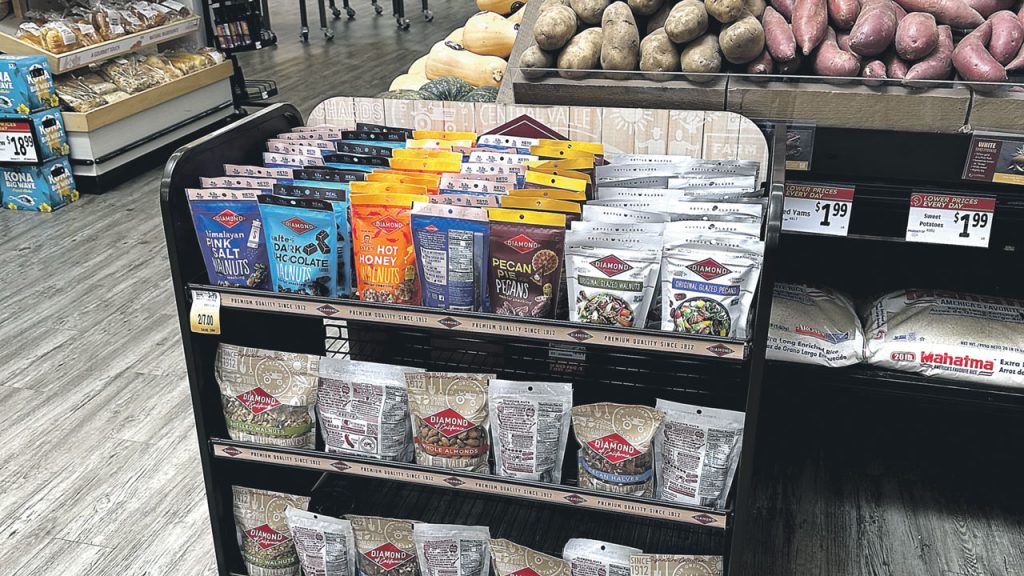Four ways to entice shoppers who love salad to add variety, produce into baskets.
Summer and salads go together. Witness the rise in the share of discussions across social media, menus, and recipes for “summer salads” that starts between March and April, hit a peak in July, and return to baseline by the end of October, according to Tastewise.io, an AI-powered consumer data platform for food and beverage brands, based in Tel Aviv, Israel.
Getting in shape for bathing suit season is one reason why some shoppers have salads on their minds.
“Health-conscious young adults, leading the ‘food as medicine’ movement, are turning to salads for their versatility and customizability. Salads burst with fresh, seasonal ingredients, offering endless flavor combinations and going far beyond the side dish,” says Kyla Oberman, director of marketing for California Giant Berry Farms in Watsonville, CA. “We have found a shift for berries to be incorporated throughout salads rather than just sprinkled on top as a garnish or topping. For example, berries can be tossed with leafy greens or cooked and/or used as an ingredient in dressings.”
A second recurring trend, propelled whenever there is a rise in the cost of dining out, is the consumer’s desire to make chef-inspired, restaurant-quality salads at home.
“High-end ingredients have never been more accessible, and shoppers are more frequently using specialty produce items to add sophistication to summer salads,” says Matt Hiltner, marketing manager for Babé Farms Specialties in Santa Maria, CA. “Beyond bagged salad kits, we see an increased willingness from consumers to use fresh components like baby head lettuce, colorful bunched carrots, and specialty radishes in their salads.”
Third, there’s the simple DIY desire to custom-make a salad. “Many of our shoppers are passionate about creating salads from scratch. The summer season offers the perfect opportunity for us to encourage them to explore the fresh, local, and vibrant produce available,” says Jeff Salchenberg, produce program and category manager for New Seasons Market, a 21-store chain headquartered in Portland, OR.
Charis Neves, vice president of salad kits for Taylor Farms Retail in Salinas, CA, says there’s been a rise in the company’s DIY salad kits, which shoppers customize to their liking.
“Shoppers are interested in seasonal, colorful, and nutrient-rich ingredients and experimenting more with flavor combinations, texture contrasts, and globally inspired dressings. Shoppers are also interested in salad greens beyond romaine, such as arugula, kale and spinach. Finally, grilled vegetables — think barbecue season veggies — like corn on the cob, zucchini, mini potatoes and bell peppers, are also making their way into summer salads, often as leftovers from weekend cookouts.”
Some of the company’s top sellers during the summer include Chopped Salad Kits, like Avocado Ranch, Sweet Kale, Mango Lemonade and Mexican Street Corn.
“Our newest Taco Ranch Mini salad kit makes a great on-the-go salad for travelling to the lake or beach,” says Neves. “Overall, salad toppings have expanded over the years. Croutons are still popular; and we have seen new ingredients deliver on ‘summer-time salads,’ including dried corn, dried mango, fresh pasta, chips, nuts and fruit-forward vinaigrette dressings.”
While consumer interest in health, restaurant quality, and customization are top reasons retailers should take time and effort to promote a summer salad theme, the real payoff comes in two ways. First, inspire shoppers to get creative in their salad fixings. Second, make it easy for them to build their basket with salad ingredients.
“Salads start as an empty canvas,” says Alex Jackson, vice president of sales and procurement for Frieda’s Branded Produce in Los Alamitos, CA. “Show shoppers it’s all about experimenting.”
1. START WITH THE LEAVES
The popularity of Caesar salad has made romaine a favorite green.
“We have a product called Mediterranean Hearts. It’s a combination of two stalks of romaine and one of treviso in a 1-pound pack, ready to chop and enjoy in a salad,” says Bruce Klein, director of marketing for Maurice A. Auerbach Inc., in Secaucus, NJ.
Beyond typical leafy salad greens like romaine, iceberg, baby spinach, and spring mix, says Robert Schueller, director of public relations for Melissa’s/World Variety Produce, in Vernon, CA, “Radicchio, watercress, baby arugula and Belgian endive have increased in sales.”
Endive is a leaf that requires education, according to David Moen, sales manager for California Endive Farms in Rio Vista, CA. “It’s a great item that fills the gap between lettuce and celery. The leaves can carry ingredients like blue cheese and walnuts or be used instead of tortillas to make a keto-friendly nachos salad. The white and red make it stand out on the shelf in a sea of green.”
The company grows red and white, conventional and organic, endive year-round.
“Our ripe local tomatoes and radishes are options for customers looking for fresh, colorful additions to their crisp summer leafy green salads,” says New Seasons Market’s Salchenberg.
Watercress also continues to expand beyond everyday recipes, and it’s versatility makes it a great addition to a salad. “Its exceptional nutrient density — packed with over 50 essential vitamins and minerals — makes it a natural fit for health-conscious consumers and evolving wellness categories,” says Anna Klawitter, marketing manager, B&W Quality Growers, LLC, Fellsmere, FL.
2. THINK OUTSIDE THE SALAD BOWL
Leafy greens have long been the focus when it comes to bountiful salads. However, Hiltner at Babé Farms Specialties says, “We have noticed a shift in mindset in recent years to where lettuce is not required in a salad, can even take a back seat, or removed altogether. Instead, other veggies have been taking center stage on salads.”
Hiltner says these include root vegetables like raw baby beets, specialty radishes, and colorful carrots shaved, coined, or julienned for a salad. Shaved fennel adds a fresh, licorice-like flavor profile and aroma to a salad. Fennel fronds can also be incorporated into a salad for added flavor or aesthetically pleasing garnish. Whether shaved, matchstick, or julienne cut, kohlrabi adds crunch no matter how you slice it.
“Grilled vegetables can be added to salads to create a vibrant and appealing plate, making it more fun and attractive for kids,” recommends Randee Perea, marketing coordinator for Prime Time International in La Quinta, CA. “Asparagus is known as a grill item, but we want to also have it be incorporated in salads and not just as a stand-alone item.”
According to Noah Robbins, chief executive officer and founder of Ark Foods in Brooklyn, NY, grilled shishito peppers also add flavor to a salad. “Our selection of peppers, which range from mild to spicy, can also be a great addition to coleslaw, potato, and macaroni salads.”
3. DON’T FORGET FRUIT
“We are always looking for a way to encourage our customers to add fresh Oregon berries to their mixed greens, with perhaps some nuts to add some crunch,” says New Seasons Market’s Salchenberg.
Similarly, “We’re seeing a rise in salads featuring flavors worldwide. Think Fattoush Salads with fresh berries, Mediterranean Barley Salad with Pickled Blackberries and Blueberries, and Strawberry Caprese Salad. The global inspiration found in these salads also drives the demand for other items in the produce department, as many of their ingredients haven’t been considered a mainstay in the more traditional salad,” says California Giant Berry Farms’ Oberman.
Fresh strawberries can double the basket’s total value, adds Oberman. When strawberries are included, the basket value increases by an average of 49%, according to Fusion/IRI 52-week data ending January 1, 2023.
Employ the excitement of “in-season” fruit to encourage shoppers to buy more to prepare as well as eat out of hand, recommends Brianna Shales, marketing director for Stemilt Growers LLC, in Wenatchee, WA. “Cosmic Crisp apples won’t brown once cut and work well in a salad. Cherries are a fruit that is still seasonal, and customers want to enjoy as much as they can during this short window. Peaches and nectarines can mix and match with other fruits in salads.”
Dragon fruit is also in season during the summer.
“Cut and combine our yellow Honey Dragons, red Fire Dragons, and white Snow Dragons for a refreshing salad,” recommends Frieda’s Jackson.
4. BUILD A SALAD DESTINATION
Cross-merchandising in-store and out-of-store is one of the easiest and most effective ways to get shoppers to pick up multiple ingredients for a summer salad.
“We suggest retailers create a designated area in the produce section for summer salads. This could be a table or endcap that features fresh ingredients with recipe inspiration located nearby that’s easily visible to consumers. We also encourage cross-merchandising products, such as mini displays of berries next to packaged salads or placing whole head lettuce with berries,” says Oberman.

Salad toppers, like Diamond Foods’ Crunchy Nut Toppers, are an ideal tie-in to cross-merchandise with salad ingredients. The plant-based product features walnuts, pecans, and seasonings and comes in four flavors, including bacon-free Smoky Bacon Walnuts, dairy-free Garden Ranch Walnuts, Glazed Walnuts, and Glazed Pecans.
“A 2022 survey found that the average American eats salad four times per week, and about 70% of salad eaters state no salad is complete without toppings. Our new Crunchy Nut Toppers were a response to the need for new salad topping options that were a better-for-you alternative to popular options like croutons and bacon bits,” says Doug Kozlow, senior marketing manager of Diamond Foods, in Stockton, CA.
One challenge when merchandising around a summer salad theme may be getting that point across to shoppers. One idea is a recipe card via QR code next to the produce display, recommends Hiltner. “To remain current, this QR code should be updated according to the season. In the summertime, for example, a colorful and refreshing beet salad recipe could be loaded onto a QR code next to the display of Babé Farms red, golden, and striped beets.”
Retailers can encourage multi-ingredient purchases by sampling demos featuring the final dish. In June 2024, California Endive Farms hosted manned demos at two Raley’s locations where the retailer’s signature Golden State Chicken Salad was served on white and red endive leaves.
“Sometimes the best way to market a food product is through its taste and quality, especially if it’s unfamiliar to consumers. Endives are crisp and deliciously bitter when enjoyed raw. They pair beautifully with creamy, savory toppings like chicken salad. As the summer heats up, people are searching for easy, refreshing meals, which makes this combination perfect for a quick, nutritious option or a wonderful addition to a backyard barbeque,” says Faith Garrard, executive director for fresh at Raley’s, a West Sacramento, CA-based chain that operates 121 grocery stores.
Cross-merchandise salads and salad fixings outside of the produce department, for example, in a freestanding display at the front of the store, or in other departments, such as the deli.
“Create a ‘Summer Salad Station’ display in-store, combining bagged salads with complementary items, like rotisserie chicken, feta cheese, croutons, fresh fruits, or bottled lemonade and iced teas,” says Taylor Farms’ Neves.
Lastly, one way to turn a summer salad promotion into a year-round basket builder is to make it easy for customers to buy ingredients while they look at retailers’ website recipes. The Fresh Market, a 161-store chain headquartered in Greensboro, NC, is a master at this.
For example, there are online recipes for a Watermelon and Peach Summertime Salad and a Summer Panzanella Salad. One click on each ingredient adds watermelon, peaches, lime, jalapenos, fresh mint, garlic, tomatoes, cucumbers, red onion, and fresh basil to their cart. That’s a hot buy.









